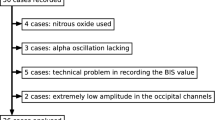Abstract
Electroencephalogram (EEG) recordings have been used for the evaluation of drug effects on brain electrical activity, and numerous studies suggest that EEG measures may be useful for the assessment of depth of anesthesia [16, 22]. It has been shown that increases in depth of anesthesia may be reflected by the appearance of EEG slow-wave activity, and decreases in fast-wave activity [20]. Arousal reactions during emergence from anesthesia have been found to be associated with EEG desynchronization with a shift to higher frequencies. Controversy exists on the EEG response indicating intraoperative arousal phenomena. In anesthetized patients a shift to EEG delta activity concurrent with cardiac and respiratory irregularities has been interpreted as an indicator of insufficient depth of anesthesia. These intraoperative electrophysiological arousal phenomena have been addressed as “reverse” or “paradoxical” arousal phenomena [1]. However, brain electrical activity is modulated not only by drug effects but also by changes in respiratory and hemodynamic parameters, body temperature, and exogenous stimuli. Previous studies have shown that EEG high voltage slow waves may also occur spontaneously or in response to auditory or painful stimulation [6, 25].
Access this chapter
Tax calculation will be finalised at checkout
Purchases are for personal use only
Preview
Unable to display preview. Download preview PDF.
Similar content being viewed by others
References
Bimar J, Bell ville JW (1977) Arousal reactions during anesthesia in man. Anesthesiology 47:449–454
Bischoff P, Kochs E, Droese D, Meyer-Moldenhauer WH, Schulte am Esch J (1993) Topographisch quantitative EEG-Analyse der paradoxen Arousalreaktion: EEG- Veränderungen bei urologischen Eingriffen unter Isofluran/N20 Narkose. Anaes- thesist 42:142–148
Brazier MA (1954) The action of anaesthetics on the nervous system with special reference to the brain stem reticular system. In: Delafresnaye JF (ed) Brain mechanisms and consciousness. Blackwell, Oxford, pp 163–199
Clark DL, Hosick EC, Adam N, Castro AD, Rosner BS, Neigh JL (1973) Neural effects of isoflurane (forane) in man. Anesthesiology 39:261–270
Drumond JC, Brann CA, Perkins DE, Wolfe DE (1991) A comparison of median frequency, spectral edge frequency band power ratio, total power, and dominance shift in the determination of depth of anesthesia. Acta Anaesthesiol Scand 35:693–699
Eger EI, Stevens WC, Cromwell TH (1971) The electroencephalogram in man anesthetized with forane. Anesthesiology 35:504–508
Engelhardt W, Carl G, Dierks T, Maurer K (1991) Electroencephalographic mapping during isoflurane anesthesia for treatment of mental depression. J Clin Moni 7:23–29
Evans BM (1976) Pattern of arousal in comatose patients. J Neurol Neurosurg Psychiatry 39:392–402
Geerts P, Noorduin H, Yanden Bussche G, Heykants J (1987) Practical aspects of alfentanil infusion. Eur J Anaesth [Suppl] 1:25–29
Hung OR, Yarvel JR, Shafer SL, Stanski DR (1992) Thiopental pharmacodynamics. II. Quantitation of clinical and electroencephalgraphic depth of anesthesia. Anesthesiology 77:237–244
Kochs E, Hoffman WE, Werner C, Albrecht RF, Schulte am Esch J (1993) Cerebral blood flow velocity in relation to cerebral blood flow, cerebral metabolic rate for oxygen, and electroencephalogram analysis in dogs. Anesth Analg 76:1222–1226
Kubicki St, Haas J (1975) Elektro-klinische Korrelationen bei Komata unterschiedlicher Genese. Aktuel Neurol 2:103–112
Li CL, Jasper H, Henderson L (1952) The effect of arousal mechanisms on various forms of abnormality in the electroencephalogram. Electroenceph Clin Neur- ophysiol 4:512–526
Madsen JB, Cold GE, Hansen ES, Bardrum B (1987) The effect of isoflurane on cerebral blood flow and metabolism in humans during craniotomy for small supratentorial cerebral tumors. Anesthesiology 66:332–336
Moruzzi G, Magoun HW (1949) Brain stem reticular formation and activation of the EEG. Electroenceph Clin Neurophysiol 1:455–473
Pichlmayr, I, Lips U (1983) EEG Monitoring in anesthesiology and intensive care. Neuropsychobiology 10:239–248
Prys-Roberts C (1987) Anesthesia: a practical or impossible construct? (editorial). Br J Anaesth 59:1341–1345
Rampil IJ, Matteo RS (1987) Changes in EEG spectral edge frequency correlate with the hemodynamic response to laryngoscopy and intubation. Anesthesiology 67:139–142
Schwartz MS, Scott DF (1978) Pathological stimulus slow wave arousal responses in the EEG. Acta Neurol Scand 57:300–304
Schwilden H, Stoeckel H (1980) Untersuchungen über verschiedene EEG-Para- meter als Indikatoren des Narkosezustands. Der Median als quantitatives Maß der Narkosetiefe. Anästh Intensivther Notfallmed 15:279–286
Schwilden H, Stoeckel H (1985) The derivation of EEG parameters for modelling and control of anaesthetic drug effect. In: Stoeckel H (ed) Quantitation, modelling and control in anaesthesia. Thieme, pp 160–168
Schwilden H, Schüttler J, Stoeckel H (1987) Closed-loop feedback control of methohexitone anesthesia by quantitative EEG analysis in humans. Anesthesiology 67:341–347
Shah NK, Long CW, Bedford RF (1988) Delta shift: and EEG sign of awakening during light isoflurane anesthesia. Anesth Analg 67:S206
Todd MM, Drummond JC (1984) A comparison of the cerebrovascular and metabolic effects of halothane and isoflurane in the cat. Anesthesiology 60:276–282
Zschocke S (1986) Diagnostic and prognostic value of EEG in brainstem lesions including spectral analysis. In: Kunze K, Zangemeister WH, Arlt A (eds) Clinical problems of brainstem disorders. Thieme, Stuttgart, pp 145–156
Editor information
Editors and Affiliations
Rights and permissions
Copyright information
© 1986 Springer-Verlag Berlin Heidelberg
About this chapter
Cite this chapter
Bischoff, P., Kochs, E., Schulte am Esch, J. (1986). “Paradoxical Arousal” During Isoflurane/Nitrous Oxide Anesthesia: Quantitative Topographical EEG Analysis. In: Schulte am Esch, J., Kochs, E. (eds) Central Nervous System Monitoring in Anesthesia and Intensive Care. Springer, Berlin, Heidelberg. https://doi.org/10.1007/978-3-642-78441-5_8
Download citation
DOI: https://doi.org/10.1007/978-3-642-78441-5_8
Publisher Name: Springer, Berlin, Heidelberg
Print ISBN: 978-3-642-78443-9
Online ISBN: 978-3-642-78441-5
eBook Packages: Springer Book Archive




